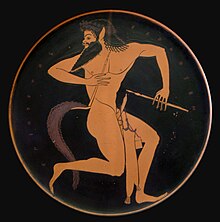Satyr
| Grouping | Legendary creature |
|---|---|
| Sub grouping | Hybrid |
| Similar creatures | Faun, Minotaur, Centaur, Harpy |
| Mythology | Greek mythology |
| Country | Greece |
| Habitat | Woodland and mountains |
In Greek mythology, a satyr (UK /ˈsætə/, US /ˈseɪtər/;Greek: σάτυρος satyros,pronounced [sátyros]) is one of a troop of ithyphallic male companions of Dionysus with goat-like features and often permanent erection. Early artistic representations sometimes include horse-like legs, but in 6th-century BC black-figure pottery human legs are the most common. In Roman Mythology there is a concept similar to satyrs, with goat-like features: the faun, being half-man, half-goat, who roamed the woods and mountains. In myths they are often associated with pipe-playing. Greek-speaking Romans often used the Greek term saturos when referring to the Latin faunus, and eventually syncretized the two. (The female "Satyresses" were a later invention of poets.)
The satyr's chief was Silenus, a minor deity associated (like Hermes and Priapus) with fertility. These characters can be found in the only complete remaining satyr play, Cyclops, by Euripides, and the fragments of Sophocles' Ichneutae (Tracking Satyrs). The satyr play was a short, lighthearted tailpiece performed after each trilogy of tragedies in Athenian festivals honoring Dionysus. There is not enough evidence to determine whether the satyr play regularly drew on the same myths as those dramatized in the tragedies that preceded. The groundbreaking tragic playwright Aeschylus is said to have been especially loved for his satyr plays, but none of them have survived.
...
Wikipedia

